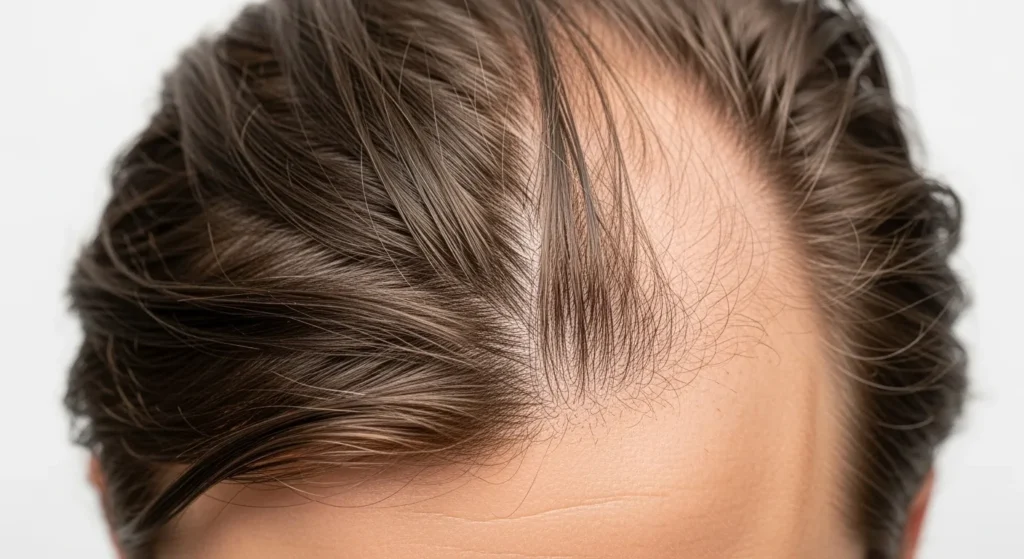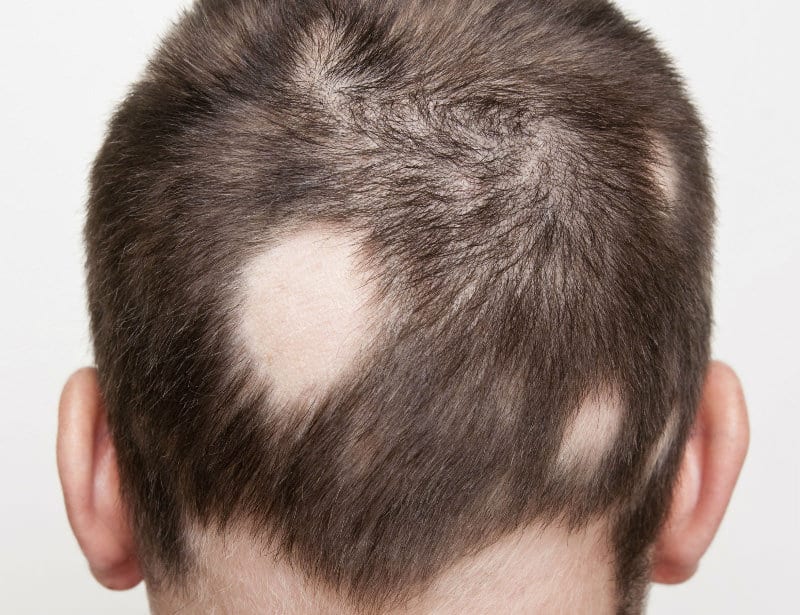Worried about a thinning spot at the crown of your head? You might be wondering if it’s a natural hair whorl or hair loss. A hair whorl is a normal spiral growth pattern, but in some lighting or angles, it can look like balding.
In this article, you’ll learn how to tell the difference, when to seek expert help, and what treatment options exist. With medically reviewed advice and real-life insights, we’ll help you navigate your next steps with confidence and clarity.
What Is a Hair Whorl?

Definition and Types of Hair Whorls
A hair whorl is a circular or spiral pattern of hair growth, typically located at the crown (top back) of the scalp. Most people have one whorl, but some have two, known as a double crown.
Types of whorls include:
- Clockwise whorls – Most common.
- Counterclockwise whorls – Less common but normal.
- Double or triple whorls – Often hereditary and completely natural.
How Common Are Hair Whorls?
Nearly every human has at least one whorl, and they’re usually present from birth. Their direction and location are genetically predetermined.
Normal Appearance vs. Signs of Concern
While a whorl can look like a bald spot, it is usually just the result of how hair radiates outward in that area. However, if you notice changes in size, density, or sudden visibility under different lighting, it could signal early-stage hair thinning.
Hair Whorl vs Hair Loss – What’s the Difference?
Natural Whorls That Look Like Bald Spots
In bright overhead lighting or when hair is wet or unstyled, whorls may appear thin, even if there’s no real hair loss. These are visual illusions caused by the direction of hair growth.
Early Signs of Hair Thinning Around the Whorl
Key signs that may indicate actual hair loss rather than a normal whorl include:
- Increasing visibility of the scalp over time
- Widening of the whorl pattern
- Hairs in the area are becoming thinner and finer
- More hair falls in brushes or on pillows
Key Differences in Pattern, Texture, and Progression
| Feature | Hair Whorl | Hair Loss |
|---|---|---|
| Shape | Circular, centered | Irregular, expands outward |
| Hair Texture | Uniform thickness | Miniaturized, fine hairs |
| Progression | Static over time | Gradual thinning and spreading |
Can a Hair Whorl Cause Hair Loss?
Is the Whorl Area More Prone to Balding?
Yes, the crown area is one of the most common sites for early signs of androgenetic alopecia (pattern baldness), especially in men.
Genetics and Crown Thinning
Men with a family history of baldness may notice hair thinning starting at the crown, right where a whorl exists. This genetic overlap often confuses.
Common Misconceptions
- Myth: Everyone with a visible whorl is going bald.
- Truth: A visible whorl isn’t always a sign of hair loss. Only progressive thinning or pattern changes confirm balding.
How to Tell if It’s Hair Loss or Just a Hair Whorl
Self-Check Guide with Mirror and Lighting
Here’s a simple method:
- Use two mirrors to inspect the crown area under natural light.
- Compare photos from 6–12 months apart.
- Look for patchy thinning or widening beyond the normal spiral pattern.
Signs of Progressive Hair Loss
- Increased scalp visibility
- Receding crown in photos
- Hair strands appear finer
- Hair loss in the family (especially on the paternal side)
When to See a Hair Specialist or Dermatologist
If you suspect a change or are unsure, consult a trichologist or a hair restoration specialist. Early intervention can stop further loss and restore density.
Causes of Hair Loss at the Crown or Whorl Area
Male and Female Pattern Baldness
Known medically as androgenetic alopecia, this condition causes hair follicles in the crown to shrink and produce thinner hair over time.
Alopecia Areata and Scarring Conditions
Autoimmune disorders like alopecia areata can also cause patchy hair loss around the crown, although this tends to be sudden and not spiral-shaped.

Stress, Hormones, and Nutritional Deficiencies
- High cortisol (stress hormone) can disrupt growth cycles.
- Deficiencies in iron, zinc, or vitamin D may contribute to crown thinning.
- Thyroid dysfunction is another common culprit.
Hairstyles That Pull on the Crown Area
Tight ponytails, buns, or braids can cause traction alopecia, especially in the crown area, leading to permanent hair loss if not corrected early.
Diagnosis and Expert Evaluation
Scalp Examination and Trichoscopy
Trichoscopy is a non-invasive diagnostic tool that magnifies the scalp and reveals signs of follicular miniaturization or inflammation.
Hair Pull Test, Density Mapping, and Biopsy
- The hair pull test assesses fragility.
- Density mapping determines how many follicles exist per square cm.
- In rare cases, a biopsy is performed to rule out inflammatory or scarring conditions.
What to Expect During a Hair Loss Consultation
A full consultation typically includes:
- Medical and family history
- Scalp imaging
- Discussion of symptoms and timeline
- Personalized treatment plan
Treatment Options for Hair Loss at the Whorl
Topical and Oral Medications (Minoxidil, Finasteride)
- Minoxidil: Increases blood flow and follicular activity.
- Finasteride: Reduces DHT, a hormone responsible for hair miniaturization.
- Both are clinically proven to slow or reverse crown thinning.
PRP, Microneedling, and Low-Level Laser Therapy
- Platelet-Rich Plasma (PRP): Stimulates growth factors in the scalp.
- Microneedling: Increases absorption of topical treatments.
- Laser therapy: Enhances cell metabolism in follicles.
Hair Transplant for Crown Area – Is It Worth It?
Crown transplants require high precision due to the natural swirl pattern.
Natural Remedies and Lifestyle Support
- A balanced diet rich in protein, biotin, and iron
- Scalp massage with essential oils (e.g., rosemary)
- Stress management and regular sleep

When to Seek Help from a Hair Specialist
Early Signs Not to Ignore
- Sudden patchy hair loss
- Progressive thinning over 6 months
- Itching, burning, or redness at the crown
Benefits of Early Diagnosis and Intervention
- Prevent further hair loss
- Improve results from medication or procedures
- Peace of mind from a correct diagnosis
Choosing the Right Hair Loss Clinic
Look for:
- Board-certified hair restoration surgeons (e.g., ABHRS)
- Clinics with trichoscopy and customized treatment plans
- Verified testimonials and before-and-after results
FAQs About Hair Whorl and Hair Loss
Can a double crown cause hair loss?
No, but it can appear like thinning if your hair is fine or light in color.
How do I know if my crown is balding?
Compare old photos, look for widening, or consult a specialist for scalp imaging.
Is it normal for my crown to look thinner under bright light?
Yes. The direction of hair in a whorl can reflect light in a way that exposes the scalp.
Can hair grow back at the crown?
Yes—if treated early using medication, PRP, or in some cases, hair transplantation.
Is a whorl the first place to go bald?
In many men with pattern baldness, the crown is one of the earliest areas affected.
Take Your Next Step
If you’re unsure whether you’re seeing a hair whorl or hair loss, it’s time to get answers. Dr. Rana Irfan in Islamabad offers expert diagnosis, cutting-edge treatments, and honest advice you can trust. Don’t wait for the thinning to get worse—book your consultation today and take the first step toward healthier, fuller hair.
